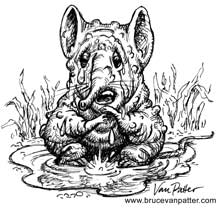The Squonk is a legendary creature reputed to live in the Hemlock forests of northern Pennsylvania.
Etymology
The "scientific name" name of the squonk, Lacrimacorpus dissolvens, comes from Latin words meaning "tear", "body", and "dissolve".
Description
The squonk is a small and ugly creature. Its skin is ill-fitting, and covered with warts and other blemishes, therefore the squonk hides from being seen, and spends much of its time weeping sorrowfully over its own ugliness. Hunters can follow the trail of tears, and find the Squonk under hemlock trees.
Powers
Hunters who have attempted to catch squonks have found that the creature is capable of evading capture by dissolving completely into a pool of tears and bubbles when cornered. A certain J.P. Wentling is supposed to have coaxed one into a bag, which while he was carrying it home, suddenly lightened. On inspection, he found that the bag contained only the liquid remains of the sad animal.
History
Legends of squonks probably originated in the late nineteenth century, at the height of Pennsylvania's importance in the timber industry.
The earliest known written account of squonks comes from a book by William T Cox called Fearsome Creatures of the Lumberwoods, With a Few Desert and Mountain Beasts (1910). Mr. Cox's account is reprinted in Jorge Luis Borges' Book of Imaginary Beings (1969).
Theory
Squonks are also known in chemistry and biology. Some substances are stable in solution or some other "wild" form but cannot be isolated or captured without actually catalyzing their own polymerization or decomposition ("dissolving in their own tears"). For example, a molecule containing a carboxylic acid moiety and an acid labile moiety might be stable when initially prepared as the salt (e.g., barium prephenate) but unstable as the free acid (prephenic acid). Other examples can be found in: Toby J. Sommer, "Chemical Squonks", Chemical Innovation, 2000, 30 (April 2000), 24-32. ISSN 1527-4799. Chemical Abstracts: 133:73580 ; CAPlus: 2000:254494.
Popular culture
- Mario Bava's 1971 film, Twitch of the Death Nerve (aka Carnage), written by Bava, Giuseppe Zaccariello and Filippo Ottoni, features dialogue around the ten-minute mark describing the squonk and its attributes.
- Steely Dan mentioned the creature in the song "Any Major Dude Will Tell You" on their 1974 LP, Pretzel Logic with the lyric "Have you ever seen a squonk's tears? Well look at mine."
- The third track on Genesis' 1976 album A Trick of the Tail (the band's first album after Peter Gabriel left the band and Phil Collins took over singing duties) is "Squonk". The song recounts the legend of the hunter who captured a squonk, as described above.
- A 2002 short story by Glen David Gold entitled "The Tears of Squonk, and What Happened Thereafter" alludes to the myth and gives the name to the deceitful clown of the story, who cries "heedless crocodile tears."
- The alternative theater and performance art company Squonk Opera is not named after the squonk, but as an onomatopoeia of the sounds made by the group's jazz saxophonists.
External links
- Fearsome Creatures of the Lumberwoods (William T. Cox's Book)
- Illustration
- Fearsome Critters par Richard Svensson

